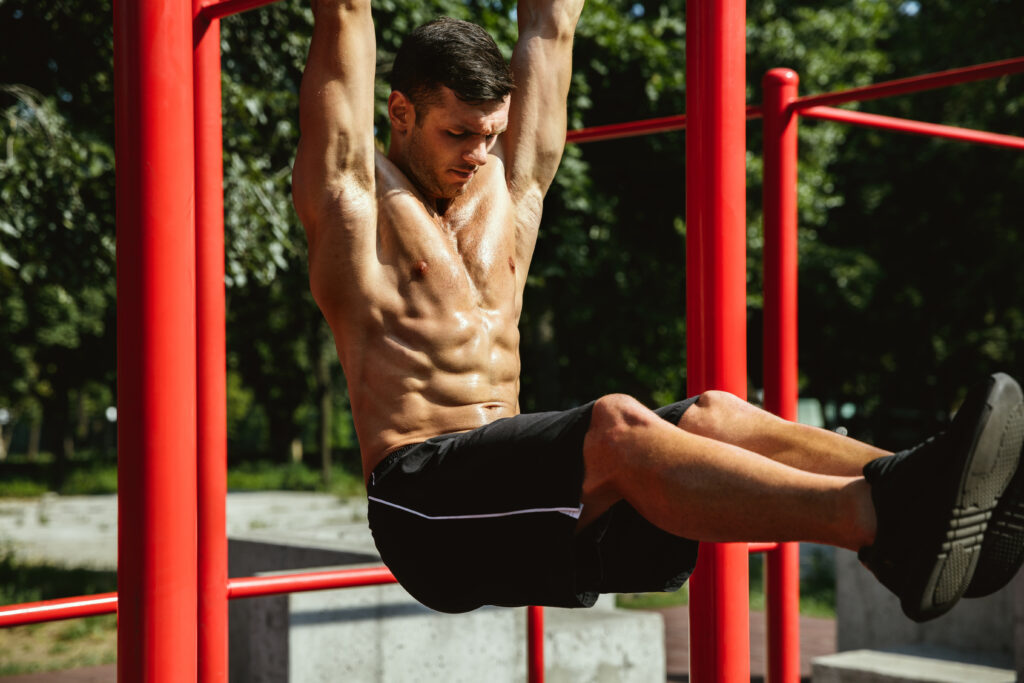How To Build Muscle With Calisthenics? A Complete Guide
When building muscle, people picture heavy barbells, weight machines, and hours spent in the gym. People often ask themselves, “Can they build muscle through calisthenics?” or is it necessary to go to a gym and lift weights? The simple answer is yes! Calisthenics, the practice of using bodyweight exercises like pull-ups, push-ups, and squats, has gained popularity for its simplicity and effectiveness. It is not just for beginners or those looking for functional strength. It is an effective and practical pathway to building lean and powerful muscles.
In this article, we’ll walk you through how calisthenics works, the science behind muscle growth, and the strategies you can use to maximize your results. Whether you’re looking to start your fitness journey or add variety to your routine, calisthenics offers a flexible and accessible option to achieve your goals

1. How Does Calisthenics Build Muscle?
When you work out with calisthenics, you use your body weight to strengthen your muscles. The idea is that your muscles break down during exercise and grow bigger and stronger when they recover. The more you push yourself, the stronger you get.
The key to building muscle with calisthenics is progressive overload. This means making your workouts harder over time. You can do this by:
- Increasing the number of reps (how many times you do an exercise).
- Trying more challenging variations of the exercise (like changing from push-ups to diamond push-ups).
- Adding extra sets (doing more rounds of exercises).
If you keep pushing yourself and challenging your muscles, they will grow stronger and bigger. So, does calisthenics build muscle? Absolutely, but you need to keep increasing the difficulty of your exercises.
2. What Kind of Calisthenics Is Best for Muscle Growth?
To build muscle with calisthenics, focus on exercises that challenge your whole body. Some exercises that are great for muscle gain include:
- Pull-ups and chin-ups: These help build your back, biceps, and forearms.
- Push-ups: Work your chest, shoulders, and triceps.
- Dips: These target your chest and triceps.
- Pistol squats: A one-legged squat that helps build leg strength.
- Planks: Planks help develop the muscles around your abdomen for core strength
Calisthenics does not require any fancy equipment which is one reason it’s a great way to train anywhere. But it’s important to remember that you need to progress gradually. Start with easier versions of exercises and work your way up to more difficult ones as your strength grows.
3. What Are The Benefits of Doing Calisthenics?
Calisthenics is more than just a workout routine, it is a whole-body, functional, and accessible form of exercise that offers numerous advantages. Here are some benefits of including calisthenics in your fitness journey:
3.1 Builds Functional Strength
Calisthenics improves your ability to perform everyday tasks by improving strength, balance, and coordination. Exercises like push-ups, pull-ups, and squats mimic natural movement patterns, making your body stronger and more efficient.
3.2 No Equipment Needed
One of the greatest advantages of calisthenics is its simplicity. You can train anywhere and any time, without expensive equipment or a gym membership.
3.3 Increases Muscle Endurance and Growth
By progressively challenging your body with harder exercise variations or increased reps, calisthenics effectively builds muscle mass and endurance. It is a complete workout that promotes both strength and stamina.
3.4 Improves Flexibility and Mobility
Calisthenics includes dynamic movements that engage multiple joints and muscles, improving flexibility and range of motion. This helps reduce the risk of injuries and improves overall physical performance.
3.5 Promotes Weight Loss and Fat Burning
Calisthenics is a full-body workout that raises your heart rate and burns calories while building lean muscle. This makes it an effective way to lose fat and maintain a healthy weight.
3.6 Improves Core Stability
Most calisthenics exercises engage your core muscles to stabilize your body. This strengthens your abs, improves posture, and protects your lower back.
3.7 Accessible for All Fitness Levels
Calisthenics can be made to suit beginners and advanced athletes alike. Start with basic exercises and gradually progress to more challenging variations as your strength increases.
3.8 Improves Mental Health
Like other forms of exercise, calisthenics releases endorphins that improve your mood and reduce stress. Plus, the sense of accomplishment from mastering new skills adds to its mental health benefits.
4. Hypertrophy Explained
Hypertrophy is the scientific term for muscle growth. When you do resistance exercises like calisthenics, your muscles go through a process of breaking down and repairing. This process makes your muscles grow bigger and stronger.
For hypertrophy to happen, you must challenge your muscles enough to cause tiny tears in the muscle fibers. After the workout, your body repairs the muscle fibers, making them thicker and stronger. To encourage hypertrophy, aim for:
- High Volume: Do more sets and reps to create enough muscle fatigue.
- Moderate Rest Periods: Rest for 30-90 seconds between sets.
- Proper Nutrition: Eat enough protein to support muscle repair and growth.
It is important to understand that hypertrophy takes time. The more you train and eat properly, the bigger and stronger your muscles will get.
5. Mistakes Most Guys Make While Trying to Gain Muscle with Calisthenics
When people first start training with calisthenics, they often make mistakes that prevent muscle growth. Some of the most common mistakes are:
- Going Too Hard, Too Fast: Doing too many exercises or too many reps too quickly can lead to injuries and burnout. Start with easier variations and gradually make the exercises harder.
- Not Eating Enough: If you’re working out hard but not eating enough food, your muscles won’t have what they need to grow. It is important to eat enough calories and protein to support muscle growth.
- Not Sleeping Enough: Sleep is when your body recovers and your muscles grow. Without enough rest, you won’t see the results you want.
- Not Being Consistent: You can’t just work out for a week and expect to gain muscle. Consistency is key to building muscle over time. If you avoid these mistakes and focus on your training, diet, and rest, you’ll see muscle growth with calisthenics.
6. What Are The Tips for Getting Maximum Benefit from Calisthenics?
To make sure you get the most out of your calisthenics workouts, follow these tips:
- Progress Gradually: Increase the difficulty of your workouts over time. This will keep your muscles challenged and promote growth.
- Train Consistently: Work out at least 3-4 times a week. Consistency is important for muscle growth.
- Use Compound Movements: Focus on exercises working multiple muscle groups, like push-ups, pull-ups, and squats. These exercises are the best for building muscle.
- Mix It Up: Change your routine every few weeks to prevent hitting a plateau. Try different exercises or increase the number of sets and reps.
- Take Rest Days: Your muscles need time to recover and grow. Don’t train every day, rather give yourself rest days in between workouts.
By following these tips, you’ll maximize your muscle-building potential with calisthenics.
7. Does Calisthenics Build Muscle as Effectively as Weight Lifting?
Many ask themselves whether calisthenics is as effective as weight lifting for building muscle. The answer is yes! Calisthenics can build muscle just as well as weight lifting if you do it correctly. The key is to keep challenging your muscles and make sure you’re progressively overloading your body.
If you want to build large muscles, weight lifting might be more efficient because you can easily increase the weight to keep challenging your muscles. But if you want a lean, strong, and functional physique, calisthenics is a great option.
In the end, can calisthenics build muscle? Absolutely. You just need to train smart and stay consistent.
Conclusion
Building muscle with calisthenics is possible, and it is a great way to get stronger without needing any equipment. Focusing on progressive overload, doing compound exercises, and eating enough to support muscle growth, gets you great results. Just remember to avoid common mistakes, be consistent, and take care of your body by getting enough rest and recovery. Whether you’re training for strength, muscle mass, or just overall fitness, calisthenics can help you achieve your goals.
With patience and dedication, you’ll see your muscles grow stronger, and you’ll become more confident in your physical abilities. So, give calisthenics a try, stay consistent, and watch your muscles grow!
FAQs
Q: Can you build muscle with just calisthenics?
A: Yes, you can build muscle with calisthenics by using bodyweight exercises like push-ups, pull-ups, and squats. The key is to progressively overload your muscles by increasing difficulty, reps, or sets.
Q: What are the best calisthenics exercises for muscle growth?
A: Exercises like pull-ups, push-ups, dips, pistol squats, and planks are excellent for building muscle. They target multiple muscle groups and can be made more challenging as you progress.
Q: How long does it take to see muscle growth with calisthenics?
A: Muscle growth depends on factors like consistency, diet, and difficulty of the exercise. You may start noticing strength gains and muscle definition within 4-8 weeks, but significant growth can take several months.
Q: Is calisthenics as effective as weightlifting for building muscle?
A: Calisthenics can be as effective as weightlifting for building muscle if done correctly. However, weightlifting allows for easier incremental loading, which might be advantageous for building larger muscle mass.
Q: What should I eat to build muscle with calisthenics?
A: A diet rich in protein, complex carbohydrates, healthy fats, and sufficient calories is essential. Protein sources like chicken, fish, eggs, and legumes help repair and grow muscles.
Q: How often should I train with calisthenics to build muscle?
A: Training 3-5 times per week is ideal. Focus on different muscle groups each session, incorporate rest days for recovery, and ensure progressive overload in your routines.


